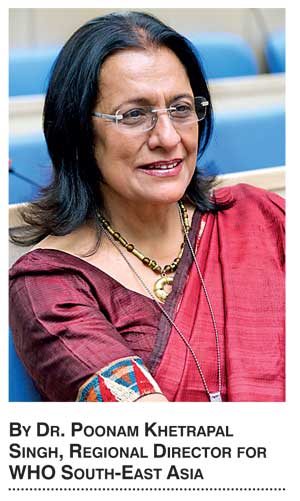Monday Apr 21, 2025
Monday Apr 21, 2025
Monday, 8 May 2017 00:03 - - {{hitsCtrl.values.hits}}

Why good public policy holds the key to safer roads
Motor travel has had a profound impact on the modern world. Road networks have linked communities. Local transport systems have changed lifestyles. And ever-greater mobility has advanced social and economic progress. The simple joy of driving, meanwhile, has rapt enthusiasts since an engine was first hitched to four wheels and a drive shaft.
And yet despite these common goods, there is a tragic downside: Mass injury, disability and death. In the WHO South-East Asia Region approximately 316,000 people die every year on our roads, equating to around 865 fatalities each day. 20 to 50 times that number are injured or disabled and require long-term care. Road fatalities are the leading cause of death among young persons, while road safety incidents are costing upwards of 3% of GDP. That’s before accounting for medical expenses.
This devastating toll is often chalked up to rising rates of vehicle ownership. Not true. High income countries account for just 10% of road deaths, despite having 46% of the world’s motor vehicles. It is also explained away by reference to ‘human error’. That’s a fallacy. The vast majority of ‘accidents’ could have been avoided by better use of road safety technology such as barriers, rumble strips or signage. Their impact could also have been lessened by safer vehicles.
Though the behaviour of road users matters, poor public policy is at the root of the problem. The upshot? Good policy can bring about immediate change. Action in four key areas can diminish injury and death on roads across the Region, and help achieve the Sustainable Development Goal of halving the number of global deaths and injuries from road traffic accidents by 2020.
First, road safety authorities must have the data needed to act efficiently. Good data allows authorities to analyse and understand the factors causing road crashes, as well as to devise and implement cost-effective solutions. This could be as minor as installing a guardrail on a switchback, or as substantial as demolishing a high-risk road and building it anew. Clear lines of responsibility and partnership among government agencies and stakeholders can help this process, especially given the problem’s multi-sectoral nature.
Second, infrastructure must be tailored to the needs of vulnerable road users. On average 50% of road deaths across the region occur among pedestrians, cyclists and motorcyclists. In some countries this figure rises to more than 80%. Bicycle lanes, pedestrian crossings and enforcement of helmet laws among other interventions can dramatically reduce these numbers. And they can do so in a way that makes our cities less car dependent.
Third, motor vehicles must be manufactured to higher safety standards. Just two of the region’s countries currently apply any of the seven priority international vehicle safety standards, such as seat belts and electronic stability control. Not a single country applies all. Priority safety features should be present in all new vehicles; the inclusion of more advanced technologies should be encouraged. Consumers have immense power in making this happen, and in creating a groundswell for national regulations to be harmonised with global standards.
Finally, responsiveness to post-crash emergencies must be increased. When every second counts, a nationwide emergency phone service is critical. So too are efficient pre-hospital response and hospital trauma care systems. On all counts, more work is needed. In addition, steps should be taken to enhance early rehabilitation and support for road crash victims. This will help avoid long-term complications and enhance quality of life. It will also reduce health care usage over the life-course.
Still, as safe as our roads become, they will never be entirely human-proof. Each one of us can limit the prospect of an incident and protect ourselves and our loved ones by slowing down, by desisting from drink-driving, by using seat-belts and child restraints, and, when riding a motorcycle, by wearing a helmet. These actions will reinforce government-led initiatives, and will also promote society-wide change.
This emphasis on broad-based ownership is crucial. Though motor travel is a welcome marker of development and increased autonomy, its public health impact is shared across society. As motor vehicle ownership in the region increases, and as countries seek to advance public health and productivity, creating safer roads through good public policy is both readily achievable and necessary. Taking the wheel on road safety is a duty that cannot be foregone.